That Last Mile To A Light Rail Station
Recently I posted about the lack of transit oriented development (TOD) around the Wellston & Rock Road MetroLink light rail stations (see Let’s Build Around Light Rail). Both stations have been open for 19 years now.
For both I made my observations from each station and seeing a lack of connection in various directions. Last week I found myself 9/10ths of a mile from the Wellston station so I got to experience the problems area residents face in reaching that particular station. Before I get into the problems I want to explain why I was nearly a mile from that station.
Walkability expert Dan Burden was in St. Louis for a few days last week. Thursday morning a group met at the MET Center near the Wellston station and did a “walking audit” of problems we observed.
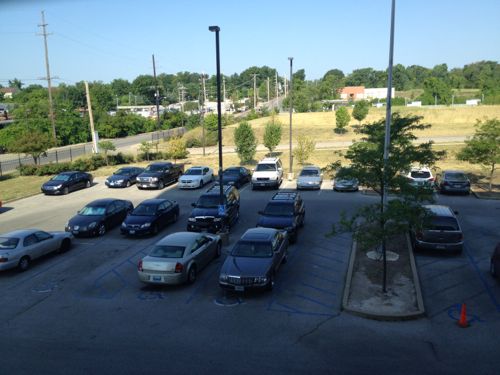
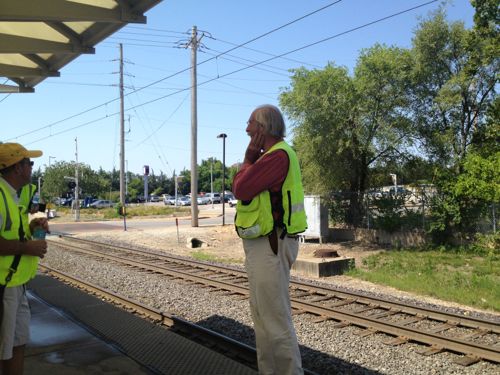
The next afternoon a group met at the University City Library on Delmar at Kingsland (map) to discuss safe routes to schools. I’d arrived by MetroBus (#97). After the presentation we walking north to the new Pershing school. Well, it was very hot so everyone else drove and I made my way the 8/10th of a mile to the school.
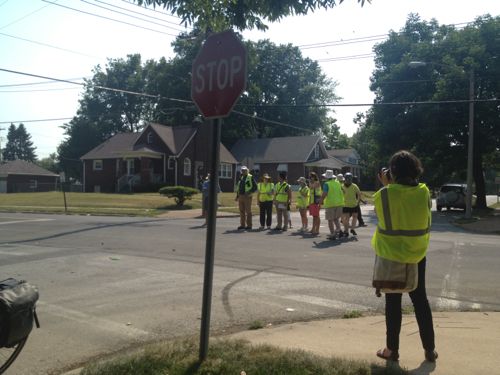
It was over 100 degrees and when we finished here the sessions were over, we were all on our own. A bus route was close but the sidewalk to reach it was blocked by construction at the school. I decided to “walk” to the Wellston Station in my power chair. I’m not sure when I left University City and entered Wellston.
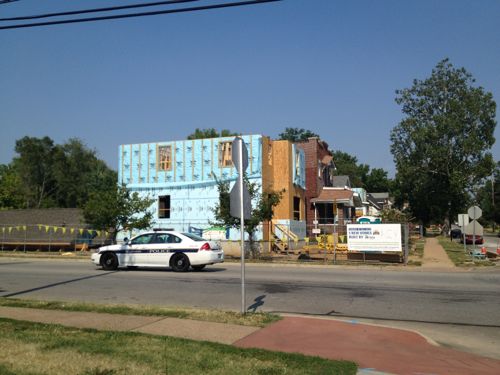
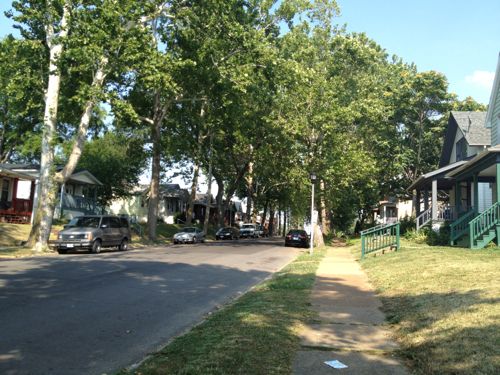
The housing stock in Wellston appears older and not as nice even when new as the housing in nearby University City. Though modest, I didn’t feel unsafe in what many would consider a “bad area.” I encountered no one, probably because of the excessive heat. The sidewalks were all complete and passable until I got out of the residential area and into the industrial area near the station. Sixty-sixth street only had fragments of sidewalks, I ended up in the roadway.
The last part of my trip would take me through Robert L. Powell Park.
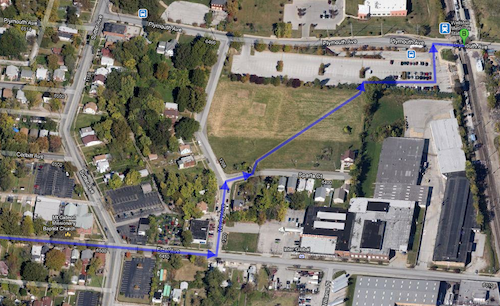
I’d seen the park on map before and got up to it back in April to see the sign facing Metro’s largely empty parking lot.
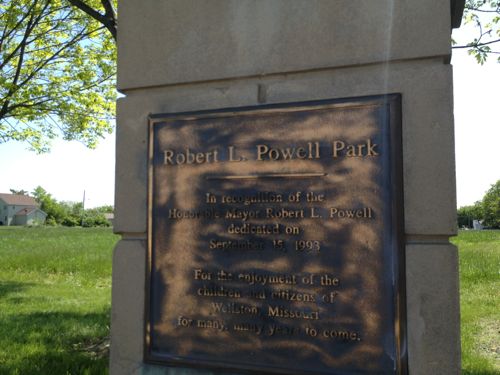
The park is appropriately named because it’s a disgrace.
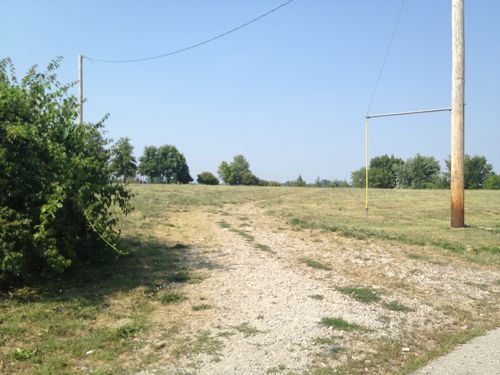
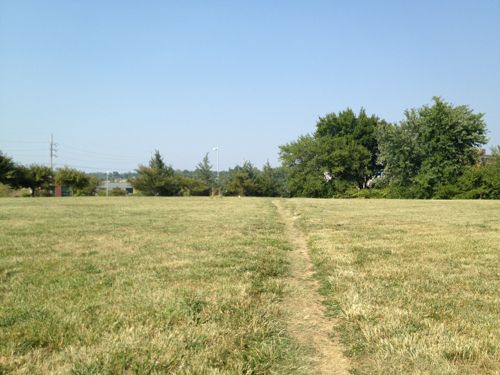
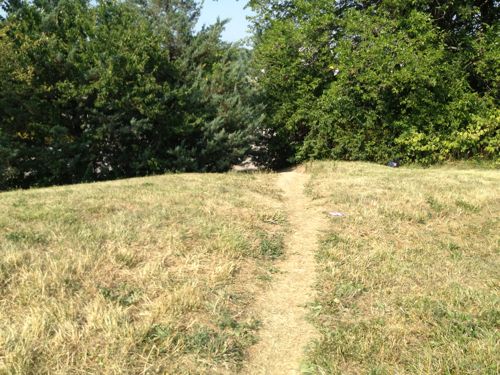
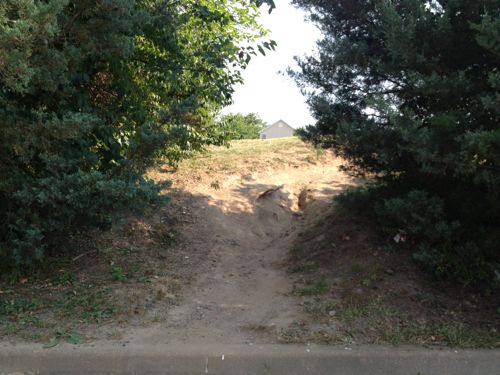
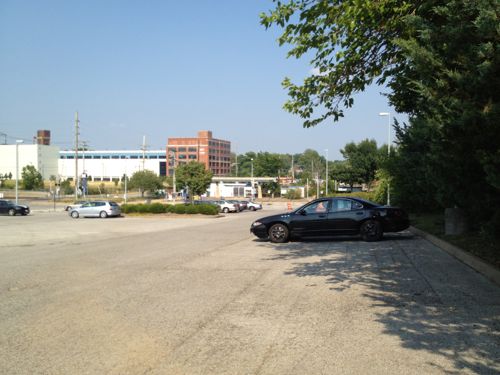
Once I reached the station I didn’t catch the train, instead I got on the #94 (Page) MetroBus since that’d drop me off only a block from my loft. It’s clear to me that in the last two decades nobody has done anything to make it easier for Wellston residents to get to transit. What can/should be done?
- Replace sidewalks along 66th Street.
- Pave path through Powell Park, plant shade trees along path and have a few benches and a water fountain. Will require a ramp to navigate the grade change.
- Rename the park something besides a disgraced former mayor.
- Develop the parking lot, provide a nice sidewalk to reach the light rail platforms and bus stops.
– Steve Patterson
It.
Is.
Wellston.
Clearly, hundreds of thousands of dollars of park improvements isn’t a priority, nor should it be.
Yes millions being spent on a new road in north county is more important because we all know motorists are more important than pedestrians.
Limited funds are being spent for the greater good affecting more people. You naively think that grants and foundations are overflowing with money, but your simplistic solutions are not realistic.
I’ll quote you in my post about when the connection is made.
Ideas 1, 2, and 3 are extremely cheap. (Well, 3 might be politically expensive.)
#3 is optional, just depends on the mood of the locals.
“Cheap”???? That much site work including bid documents, removals, survey work, excavation, concrete placement, railings, paint, backfill! Your idea of ‘cheap’ may be linked to your unfamiliarity of the work, I hope!
I’ve never been to Wellston– that I know of, so I’ve never seen the Metro station or the city park and cannot personally verify the conditions described in this post. But if the ONLY pedestrian access to the Metro stop is that single unpaved pathway in Powell Park as shown in the photographs, then I think the necessary improvements should be made–at taxpayer expense– to improve accessibility–to address that problem only–if and only if that is the only pedestrian access to the station. But otherwise, the other issues cited, especially the benches and drinking fountains, should be put at the bottom of a list of some-day (maybe) improvements, and then ONLY after some wealthy Wellston resident dies and earmarks adequate funding for that specific improvement. 66th Avenue appears to be a residential street. If so, isn’t responsibility for those sidewalks that of the residents?
66th isn’t residential, it has some houses but it’s mostly industrial. It’s in contrast to the other streets which are very walkable. There are federal grants and foundations that could be sources of funds to pave the worn path. Local businessss might be willing to support part of the costs. Metro might have access to funds designed to improve access to transit.
Aren’t commercial/industrial property owners responsible for the maintenance of sidewalks that front their property? If not, I wonder why not? And if so, why should “government” fund the sidewalk removals/replacements? And why should Metro commit to even partial funding? Metro has to save their pennies to fund “construction management” firms that sometimes forget to “manage”.
While I appreciate your passion and your dedication to these issues. I must respectfully disagree on this particular issue / battle. The fundamental problem with this Metrolink line is that Bi-State Develoment took the path of least resistance, literally and figuratively, when the line was originally constructed, using an abandoned FREIGHT rail line. This station is located in what was once a thriving industrial area, NOT a walkable urban neighborhood. Go to Historic Aerials – http://www.historicaerials.com/ – and put in the station’s address – 6450 Plymouth Avenue, Wellston, MO. – and you have the same non-walkable infrastructure in 1958 and 1933 as you have today! The only difference is that the surrounding area has declined, precipitously, so you now have lots of vacant land that “can” be redeveloped using TOD.
As for a couple of your suggestions:
2. Pave the path through the park? Maybe. What other park uses are planned? A paved path that bisects a ballfield makes little sense, while a drinking fountain would be a vandalism and maintenance nightmare. This is a park first and a shortcut to transit second. The real tragedy is that the park hasn’t been developed or maintained, not that there isn’t a dedicated path bisecting it!
3. Rename the park? Hubris and unrelated! The people of Wellston chose the name and they don’t need some outsider telling them what they “should” do! Plus the park name has absolutely NOTHING to do with walkability or station access!
The good people of Wellston already have paved, off-street, pedestrian access along both sides of both Kingsland and Sutter Avenues (between Etzel & Plymouth) and along the north side of Plymouth (between Sutter and the station platforms). Just because you and others CHOSE to use a shortcut doesn’t mean that pedestrians have been ignored, and just because you made a poor, uninformed choice doesn’t mean that every potential route sucks!
The challenges you face, as a disabled pedestrian and transit rider, are not much different than the challenges many motorists face, only the scale is different. In a perfect world, it WOULD be “all about me”. I’d have a straight, unobstructed path to every one of my destinations, just like what you want. The reality is that compromises have to be made, both because our resources are finite and because there’s an infinite number of combinations of origins and destinations – you will never, ever, connect all the dots!
Part of the problem in going with an above ground light-rail system. Right-of-way/cost issues dictating where the stations go in too many instances. Extremely difficult to have TOD when the transit weren’t designed around people in the first place.
Using the billions of dollars it would have taken to build a new subway line, you could fund an incredible amount of TOD around the current line.
Or we could just skip the overpriced infrastructure entirely and switch over to a bus rapid transit system that would take advantage of our already overbuilt highway system.
You think politically that dedicated lanes could be taken away on our highways for BRT when we are still adding lanes?
I think our highways are spacious and over built enough that we don’t need dedicated bus lanes to make bus rapid transit work.
You’re right that Wellston residents are the ones that should decide if the park name remains or gets changed. You’re wrong though about the area. It’s only the last block that it gets industrial rather than residential. That short distance should have been addressed so people don’t have to walk through mud and tall grass when it’s not cut. After a long day at work people want the shortest most direct route home. This park is a field. No improvements exist. Nothing. It’s a blank canvass, ready for ideas the potential park users may have.
Addressed by whom? Metro is not a bottomless well of funding for sidewalks. The city of Wellston (should? apparently?) benefits from having a station in their city. The city of Wellston should be providing the necessary infrastructure for their residents and visitors to access this publicly-funded amenity! What is your concept? That Metro needs to draw a quarter-mile circle around every one of their stations and to pay to fix every one of the barriers to access?! A half mile? A mile? You can’t even get off the west end of the Metrolink platform in Clayton, down to Brentwood Blvd., on Metro’s own property! The world is full of projects that “should” be completed, because they will help someone or dozens or hundreds, only you seem to be focused on the concept of spending “other people’s” money. The real answer is to convince the city fathers of Wellston that it’s more important to build sidewalks than it is to pay for things like police protection!
“That Metro needs to draw a quarter-mile circle around every one of their stations and to pay to fix every one of the barriers to access?! A half mile? A mile?”
Yes, if they want people to use their system.
This is Wellston. Be realistic, the park WON’T be maintained. Spend a few thousand dollars pouring concrete for a shortcut, and no maintenance will be needed for the next 20 years.
…just order out a few ready-mix trucks, gather up some of the locals standing around on corners and in the streets, and start p o u r i n g concrete! That’s all it will take! And after you’ve spent a “few thousand dollars” you will have created a nightmare and a hazard and you’ll be about 75′ closer to the other end with your shortcut! But stick around. You gotta be there for the initial lawsuits.
1 minute walking time saved
200 people walking to Metrolink per day
365 days a year
60 minutes per hour
Minimum wage $7.25
1*200*365/60*7.25=8820
Every year you will save Wellston residents something like $8000 worth of minimum wage labor.
What is the cost for a cheap concrete path? Surely this would pay for itself pretty quickly.
Times <2 ! After the return trip on Metro, don't most riders have to walk the path a second time? So wouldn't the savings be $+/- 16,000.00 annually, unless they get a raise? ….still not enough to cover the costs of the sidewalk/ramp improvements, IMO!! ( 1 x 3.33331 x 365 x 7.25 x 2 ) And don't you have to also factor in the reduced/increased traffic on some Saturdays and Sundays, and holidays?
Of course, it was just a rough estimate. Maybe it’s 1 minute time savings round trip. Anyway, how much do you think the improvements would cost? Googling quickly, I see costs of $5-9 per square foot for sidewalk. Add a good amount for the stairway at the end, it still ends up at no more than $10k overall.
Eric: $ 10 K won’t even cover the cost of the initial survey! Then add the cost of the bid documents ($$$). After the project has been bid, the contractor has to buy a permit ($$$$). Sitework prep, sidewalk construction and ramp (not a stairway) construction come next (mucho $$$$$$$$$$$). Then you’re going to have to provide lighting–can’t have a disabled ramp in the middle of a field without some sort of lighting, and a flashlight won’t work!(add more $$$$$$)
I’ve never been to this “park”. I wouldn’t know where to find it, or in what direction to drive to attempt to find it. I’ve never seen the area where the sidewalk and ramp would be constructed. So I don’t know if 100′ of sidewalk is needed, or 500′. I don’t know if the elevation differential at the handicap ramp is 5′ or 10′ or more. So I can’t provide you with an estimate. But I’m certain that, by the time the last bit of backfill is completed, you’re not talking about spending less than $100K, and that’s probably VERY LOW!
I live on Chamberlain, just a few blocks away from the Wellston station. I took trains to/from work for the first 4 years I lived in STL (2006-2010). I know this station, its issues, and the surrounding context, oh so well.
The station is a poor, crass joke on it’s users. Pedestrians don’t have a complete sidewalk on Sutter or Etzel (it’s broken too badly/destroyed/never completed in several places). Not only that, but Steve’s point about the parking lot placement is dead-on: because of the neighborhood, the lot is never more than 1/4 full, but its design means that peds have to navigate 4 different crossings, and then once you finally get up close to the platform you either have to cross Etzel w/o signage or cut into the parking lot itself (depending on which direction train you want).
I’m surprised Steve didn’t mention this, bus connections are easy to make here, because of how wide Etzel is at that point and smart placement of the bus stops & shelters. Only 200ft or so from a Metrolink platform to a bus shelter.
As for the field, another joke. It’s not a park, it’s a field that is occasionally mowed by the city of Wellston. The ONLY use it has, for the last 6 years+, is a poor cut-through to get form south of Etzel to the station. There’s some dense UCity blocks south of Etzel that could use improved access. JZ71, your objections are ignorant. If you don’t know the specifics of a situation, don’t start fantasizing different scenarios in order to manufacture objections. It’s called argument from counterfactuals, and it’s a logical fallacy.
Wellston needs to fix SOME of these problems, but first they need to stop pulling guns on each other (domestic level, street corner level, city hall level!). Metro needs to fix SOME as welll. UCity is also at fault for sidewalk neglect and neighborhood neglect. Plenty to blame, but also some money (UCity is running a surplus, Bi-State has maintenance/improvement funds, Wellston…needs to stop shooting). Fozzie & mrsdls, just because Congress sucks at budgeting doesn’t mean that we can’t fix infrastructure problems, especially small, specific ones at the local level.
As it is, given the Wellston context (eg: crime happens regularly at/near/around the station), I only used the Wellston station infrequently and under specific conditions. I preferred to walk the extra .5 mile to the Delmar station (which has it’s own accessibility issues, but that’s another complaint). Eric432432, nice work with the calculus, but you’re even a bit pessimistic in your assumptions! The cut through saves at least 2 minutes (though 200 ped riders every day of the year is optimistic). But, I know public transpo & multimodal system usage increases when it is no longer user-hostile, so the economic benefit is even greater than currently calculated!
If the lot is currently striped for too many cars, wouldn’t it be cheaper to keep all the pavement in place as-is, redesign the vehicle parking layout, and use striping to designate a pedestrian path?
You’re right, I don’t know this park, but I do know parks, in general, having served 20 years on Denver’s Parks Board, so I’m pretty protective of all parks. Parks have competing agendas, competing demands, and, invariably, limited funds. It’s not unusual for a park to start out like this one, as “just a field”, with development taking decades. It’s also not unusual, once any use becomes established, to be very difficult to remove or to modify said use. I’m not saying, “don’t provide access thru the park”, I’m saying that it’s more complex than just paving an existing dirt path, you gotta have a plan.
As for the fact that “Pedestrians don’t have a complete sidewalk on Sutter or Etzel (it’s
broken too badly/destroyed/never completed in several places)”, that falls squarely on the backs of Wellston’s government officials and Wellston’s taxpayers. If / when they decide to “stop the shooting”, it’ll be up to them to decide how to spend their city’s dwindling budget. However, I suspect that better police protection and weatherization subsidies, to name just two of the competing priorities, would rank higher than new sidewalks with most Wellston homeowners
Sorry, Noel. When I studied symbolic logic, I learned that “counterfactual logic” involves introducing non-facts to prove one’s point. But your argument fails to consider a 20th Century logical argument rooted in the study of inductive or probablistic reasoning in which premises need not render their conclusions certain. (Modus Pollens)
Does Metro have land use control? If not then they are not responsible for this mess. Until Saint Louis has a regional planning authority which ties land use and transportation – that can raise and redistribute revenue to areas which need public infrastructure improvements – then these issues should be expected to continue.
You could also look at it from a different take with the simple understanding that things change and sometimes park space nor park n rides are not necessarily the best land use for an undeveloped transit station. Simply put, why not take part or most of the park and a good chunk of the park n ride lot for developable single residential? Heck, multi family residential if Wellston wants it. In other words, time to sell underutilized non tax revenue generating public land and for go the fantasy of TOD
The reality is
1) Wellston neither has the funding nor the community drive to develop this park and space fully. The point is not to argue about limited funding, but what can be done considering Wellston fiscal realities
2) This area will no longer have heavy industrial use of any measure of wishful thinking. So why not residential? Why not change the scope of area? It ‘s accessible and has transit. Saying residential won’t succeed because it was an old industrial area doesn’t make sense. If that is the case, bulldoze St. Charles county becuase you can’t have subdivisions succeed where hay was grown.
3) Metrolink doesn’t need a park n rides everywhere and this large lot was a waste of funds to begin with. Tear it up, find a developer and use the maintenance funds to rebuild/build some sidewalks to compliment the easy street access to the station. I doubt that it will break the bank if Metro would take a different approach and might save in the long run considering how much metrolink has put into pavement and decks that they now have to maintain, plow, and replace at some point. You can have different approaches for different stations.
Will it work, can’t say. Will some one develop and be able to sell lots, can’t say. but obviously something needs to chance and it isn’t a sidewalk. A sidewalk should be the result of something more fundamental to what exists as the freight tracks are long gone, industry is long gone and what is in its place is metrolink.